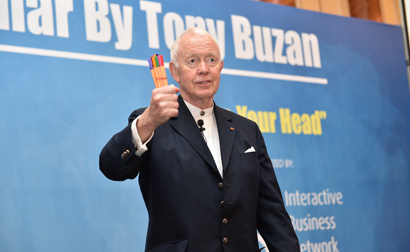Mind mapping: A manual to make the most of the human brain
Tony Buzan, the pioneer of the concepts of mind mapping, speed reading and memory boosting, was in Doha last month for a day-long seminar entitled ‘Use Your Head’. The presentation dealt with topics such as knowing the brain, the essential mind tools for higher-capacity brains and efficient learning. On the sidelines of the event, speaking with The Edge’s Aparajita Mukherjee, in an exclusive interview, Buzan shares his insights on what he has spent his life doing: helping people learn better by using their brains more efficiently.
 Tony Buzan, the pioneer of mind mapping and speed reading techniques, addressing an audience at Doha.
Tony Buzan, the pioneer of mind mapping and speed reading techniques, addressing an audience at Doha.The day-long seminar with Tony Buzan began with anecdotes from his early childhood, into his university days when he felt that he was suffering from an information overload.
Detailing his student life experiences, Buzan told The Edge, “My black and white linear notes written down assiduously during the lecture courses were becoming monotonous and the entire process of memorising those notes was demotivating and boring.” This is when he decided to visit the university library and asked where the section on how to use the brain was.
The librarian directed Buzan to the medical section, but he told the librarian that he did not want a book about brain illnesses and diseases but a manual on how to make the most of his brain. The librarian responded that such a book did not exist.
This is when Buzan reasoned that every electrical appliance or piece of machinery came complete with an instruction manual; however, the human brain, the most complex organ in the known universe, had no such manual. Buzan says, “I therefore decided to write it myself and in that process mind maps were born. I realised that black and white was literally a monotone, the root of monotonous, that is, boring and sleep inducing. The more I looked at it, I realised that the student libraries of our major universities had become giant dormitories for tired, exhausted and sleeping brains.”
Does Buzan apply the techniques of mind mapping and boosting memory to himself? “Yes, of course I do. Once I had realised that there are structures in nature, natural architecture, which mirror our patterns of thought generation in our brains, it is then I had unlocked the key to the brain manual I had so powerfully both visualised and desired,” says Buzan. He adds that once he had made the breakthrough to understanding the workings of the human brain, he had also discovered the tools for using the brain more efficiently.
Commenting on these tools, Buzan names mind mapping and speed reading. In Buzan’s opinion, “These are the forgotten secrets of memory enhancement, boosting and power which I use myself in my global endeavours and which I also promote to millions of eager human beings across the planet, who are hungering and thirsting after the knowledge which will supercharge their thinking apparatus, to use their heads in the way that should be intended.”
According to Buzan, the techniques that he discovered underpin the principles of mind mapping, speed reading and memory – the triple pillars of what he calls “mental literacy, the creed which I promulgate around the globe”.
One recurrent theme through the seminar was Buzan’s assertion that the human brain is like a sleeping giant. Explaining what he means by that, Buzan says that if one looks at the history of the human race, certain individuals stand out such as Alexander the Great, Julius Caesar, the philosophers Averroes, Aristotle and Avicenna, Queen Elizabeth I, Shakespeare, Newton, Leonardo da Vinci, Marie Curie, and Einstein, among others. He adds, “We might at best enquire how this exclusive club of personalities was established. Who elected them? Why are they in the club and others are not? Is the rest of humanity simply made of inferior material to these supermen and women?
“I began by asking who decides who is intelligent and I realised that anyone, by unlocking the true potential of their own brains and by using the previously undisclosed secrets of mental literacy, can aspire to awakening their brains and joining the genius club. There is no automatic bar or impediment to entry.”
Buzan is emphatic that anyone who learns the global mental literacy techniques and applies them, opens the entry door to the awakened brain.
The basics of mind mapping
Going back to his allegory that mind mapping mirrors natural architecture and reflects the infinitely branching synapses of the physical brain itself, Buzan tells The Edge, “The principles of mental literacy which I worked out as a student require colour, they demand association and they revel in the creation and proliferation of ideas. Mind maps satisfy all these functions.”
Delving into the principles of mind mapping, Buzan discloses that the key principle is to select an idea, concept or plan as one’s main topic, “be it your vacation, recalling past holidays, or planning those to come. It can centre on your finances, or an academic subject. There is no limit or constraint whatsoever on your selection of a theme.” Buzan continues that the first step towards creating one’s mind map or maps is starting with a sheet of paper and to “arm yourself with coloured pens or pencils. In the centre of the paper, preferably landscape A3, draw a colour image of your chief topic. For example for a holiday it might be a swimming pool or palm tree. Now draw radiating branches in different colours emanating from that central image to create a universe of notes and ideas”.
The rules of mind mapping, in Buzan’s view, demand only one key word per branch and as each branch proliferates from the central image; and grows fresh associated branches, one will find that a host and wealth of creative, memorable and innovative thoughts come flooding in.
Buzan furthers, “Your page becomes a reflection of the teeming flashes of brilliance in your mind, now translated into blossoming and burgeoning visual form. Your brain is stimulated, the sleeping giant awakes and the floodgates of creativity open as if by a miracle before you.”
Advising the attendees of the seminar, Buzan insists that anyone can enhance the recall power of one’s mind map by adding coloured images. “Memory,” says Buzan, “is not a dry-as-dust exercise: true and effective recall of facts you wish to remember and use, depends on the dramatic and imaginative use of image and colour.”
Buzan urges, “Become your own artist. Etch your own scientific insights onto your page.” What does a mind map do for us? According to Buzan, the mind map records notes, generates strategies, reflects the workings of one’s own mind, “now made manifest for you to see and recapture at a glance”.
Can mind mapping be applied to the workplace for the benefit of both the employee and the employer? Can it, when applied, lead to a boost in employee productivity, corporate bottom lines and ultimately national productivity?
To Buzan, it is self evident that the adoption and inculcation of all the related and associated principles of global mental literacy (of which mind mapping is a part) must ineluctably bring about serious benefits in every sphere of human activity, be it business, corporate, government, military, social or education.
Explaining how mental literacy can help increase productivity, Buzan tells The Edge, “If those at the helm have a perfect comprehension of the concepts of mind mapping, speed reading and memory, and these mental virtues and strengths are reflected and replicated within and by their support teams, it is inevitable that major benefits and advantages will accrue.”
Buzan believes that a harmonious and felicitous combination of the mental virtues throughout any organisation will lead to greater efficiency, speed of execution of decisions, designs and plans as well as coordination between all functioning elements of that organisation. “Initiatives and details will be remembered, not overlooked or forgotten and the communality of shared mentally literate templates will ensure that corporate hand and eye, body and mind, understand each other perfectly and function as one,” adds Buzan.
Effective speed reading
The other concept that Buzan has pioneered is speed reading which, according to Buzan, is the ability to absorb and understand large quantities of text at greater reaction times than the human average, which is several hundred words per minute.
Clarifying the exact method one can employ to read and absorb faster, Buzan explains, “It is very easy to significantly increase your reading speed, at first into the high hundreds (any unspecified number that is between 100 and 200, but closer to 200 than 100), then the first thousand and finally multiples of a thousand words per minute, without sacrificing comprehension.”
The three principles to bear in mind are, explains Buzan, “Firstly use a pointer when you read, such as a pen or pencil. The pointer forwards as you read and helps keep your focus on a particular place and avoid the backsliding and repeated reading of passages which is the bane of effective reading.”
The second step is to realise that the human eye span is in fact incredibly wide. “If you try you literally have eyes in the side of your head. Once you grasp this principle you can move to the third and vital lesson, which is chunking. Instead of reading single words at a time, take in chunks at once. You will find that this has an amazing effect on your reading velocity and effective absorption and comprehension,” says Buzan.
Does speed reading apply to online reading too, now that many read books on Kindle and overall reading has shifted from the printed word to online mediums?
There is no difference between the printed page and the online page, in Buzan’s opinion. Exactly the same principles apply.
Talking to The Edge about the advantages of speed in reading online rather than from the printed page, Buzan points out, “One plus is that there is no danger of your book page suddenly curling up or the book shutting inconveniently and thus losing your place.”
A further advantage of reading online is that in many cases one has the option of altering the size of the onscreen print to make it simpler to digest, at the mere touch of a keypad.
Buzan’s latest global campaign is the butterfly universal project, which is designed to reveal in dramatic and colourful form to billions of people around the planet what dormant resources of the mind are open to them .
Explaining the concept, Buzan says, “Students gather at my worldwide public lecture tours brainwashed by uninspired, rigid and conventional teaching into erroneous and reductive beliefs about themselves and their so-called limitations, and convinced that they are hopeless at art. By insisting that they all draw on the spot the most beautiful and colourful butterfly they can, the realisation dawns that they can be artists, or scientists.”
Drawing an allegory with the crawling embryonic caterpillars of human brains, Buzan continues, “Human brain capacity is infinitely capable of achieving anything it wishes to and brings us right back to my earlier point about the brain being a sleeping giant. My global mission is to awaken the entire worldwide race of sleeping giants.”
Like this story? Share it.






